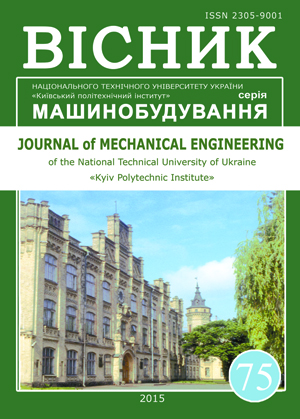STUDY OF FORGING PROCESS BY CONVEX DIES GEOMETRY WITH SEVERE PLASTIC DEFORMATION
DOI:
https://doi.org/10.20535/2305-9001.2015.75.58350Keywords:
forging, drawing, mandrel, concave dies, angle concave, bevel angle, degree of deformation, feed rate, degree of reductionAbstract
Purpose. An earlier theoretical study by FEM of forging cylinders by dies with bevels possible to establish a rational geometry deforming tool. The purpose of this experimental study – check the validity of the theoretical results on lead samples. Design/methodology/approach. The deformation of workpieces by convex dies with bevels carried out on lead samples. Prepared samples are drawing by die of cut with an angle α = 1150 with feed 0,1 D. The experimental and theoretical results forming after drawing 20 and the 40% by convex dies, elongation and change of the wall thickness of the workpiece at process of drawing without mandrel were compared. The change of relative diameter of the holes on the degree of deformation and of influence deformation degree on the intensity closing of holes during drawing process without mandrel were compared. Findings. At increasing degree of deformation during drawing without of mandrel the relative hole diameter decreases, while the intensity of closing increases, i.e. there is a thickening of the wall. The experimental results confirm the results of the theoretical study with the error of 6...12%. Originality/value. As a result, the final form hole in the workpiece during drawing has a slightly different shape than cylindrical, which explains the error of measurements hole diameter workpiece in theoretical studies.
References
Pas'ko A.N., Tkach O.A., Muravleva L.V. Matematicheskoe modelirovanie v processah rotacionnoj kovki. Izvestiya TulGU. Tekhnicheskie nauki. Tekhnologii i oborudovanie dlya obrabotki metallov davleniem. 2009. No 3. P. 195–199.
Pas'ko A.N., Tkach O.A. Modelirovanie mnogoperekhodnogo processa rotacionnoj kovki. Izvestiya TulGU. Tekhnicheskie nauki. Tekhnologii i oborudovanie dlya obrabotki metallov davleniem. 2010. No
P. 69–73. 3. Yakovlev S.P., Pas'ko A.N., Sorvina O. V. Matematicheskoe modelirovaniya processa rotacionnoj kovki konicheskih zagotovok. Kuznechno-shtampovochnoe proizvodstvo. 2000. No 9. P. 24–26.
Antoshchenkov Yu.M. Vliyanie vneshnih zon na formoizmenenie zagotovki pri kovke. Kuznechno-shtampovochnoe proizvodstvo. 2001. No 6. P. 19–21.
Sidorov A.N., Antoshchenkov Yu.M. Raspredelenie napryazhenij v ochage deformacii pri kovke ploskimi bojkami sploshnyh i polyh cilindricheskih zagotovok. Kuznechno-shtampovochnoe proizvodstvo. 1996. № 9. S. 32–34.
Antoshchenkov Yu.M., Tyurin V.A. Intensifikaciya kovki – protyazhki polyh zagotovok. Kuznechno-shtampovochnoe proizvodstvo. 1988. No 2. P. 11–13.
Kal'chenko P.P., Kachura E.D. Puti sokrashcheniya raskhoda metalla pri izgotovlenii sploshnyh cilindricheskih pokovok. Kuznechno-shtampovochnoe proizvodstvo. 1987. No 3. P. 15–16.
Markova M.A. Issledovanie deformirovannogo sostoyaniya zagotovki pri protyazhke polyh pokovok bez opravki bojkami so skosami. Nauchnyj Vestnik DGMA: sb. nauch. trudov. Kramatorsk, 2014. No 3 (15E). P. 75–82.
Markova M.A., Rizak P.I. Formoizmenenie polyh pokovok v processe protyazhki bez opravki bojkami so skosami. Obrabotka materialov davleniem: sb. nauch. trudov. Kramatorsk: DGMA, 2014. No 2 (39). P. 81–87.
Markova M.A., Zlygorev V.N., Rizak P.I. Zakovka otverstiya pri kovke bojkami s vypuklym rabochim profilem. Vіsnik DDMA : zb. nauk. prac'. Kramators'k: DDMA, 2015. No 1 (34). P. 57–63.
Markova M.A., Rozov Yu.G., Mkrtchyan E.A., Somkin A.E. Mekhanizm zakovki otverstiya pri kovke bez opravki. Obrabotka materialov davleniem: sb. nauch. trudov. Kramatorsk: DGMA, 2015. No 2 (39). P. 81–87.
Markova M.A., Rozov Yu.G., Mkrtchyan E.A., Rizak P.I. Gradient deformacij pri poluchenii polyh zagotovok s primeneniem intensivnyh plasticheskih deformacij. Nauchnyj Vestnik DGMA: sb. nauch. trudov. Kramatorsk, 2015. No 1 (16E). P. 67–73.

